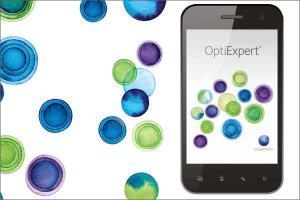
Taking a more proactive approach to the recommendation of multifocal contact lenses for presbyopic patients is widely discussed in the literature. What may now be regarded as largely historical concerns of low fit success, increased chair time and cost did understandably impact how frequently multifocal lenses were offered in the past.
Thankfully, times change, and with increasing choice of multifocal lens designs in a variety of material and modality options, along with in-office tools to support time-efficient accurate fitting, eye care professionals are well placed to move forward with confidence.
Opportunity to help so many more patients
The average age of the US population is rising; with a median age of 38 years in 2016 projected to increase to a median of 43 years by 2060.1 This increase will place an estimated 160 million people in the US into the presbyopic age range. Best estimates suggest there are around 45 million contact lens wearers in the general US population today,2 and of these, about one-third are presbyopes.3 Within the presbyopic lens wearing group about one-third, approximately 5 million, currently wear a multifocal contact lens.3 These data illustrate two key opportunities: a large gap between the number of presbyopes using spectacles only compared to those also wearing contact lenses; and within the contact lens group, that two-thirds of presbyopes do not wear a multifocal design at the moment.
Contact lenses deliver a number of quality of life benefits for wearers in general. For presbyopes, especially those emmetropic presbyopes who have not required any visual correction until their 40s or 50s, the inconvenience of needing to rely on spectacles for close work should not be underestimated. Increasingly, people feel significantly younger than their actual age: a survey of more than half a million Americans found people typically feel 20% younger than they are, with sixty year olds feeling like they are forty-six years old on average.4 This group of patients may gain significant benefits from the visual freedom contact lenses can provide. Multifocal designs provide balanced binocular vision from far to near, and can deliver more long-term satisfaction than monovision corrections that may reduce stereoacuity as the demand for reading addition increases over time.5
Supporting proactive multifocal prescribing
Successful multifocal fitting requires confidence in the outcome. Will the lens feel comfortable for the patient, providing clear vision for a wide range of their daily needs, and is it quick and reliable to fit? Contact lens material is an important consideration in this patient group with the known detrimental changes that occur to the stability of the tear film with age. Options exist for naturally wettable silicone hydrogel materials in both daily disposable and frequently replaced modalities.
Bearing a few tips in mind when fitting multifocal soft contact lenses can help enhance overall fit success. First, patient communication is important. Developing a clear understanding of the patient’s visual lifestyle helps establish if they will be a good candidate for multifocal contact lenses, for either full- or part-time wear. Clarify expectations with the patient ahead of time: some fine detailed near visual tasks may still benefit from additional reading glasses, but the majority of their day should be comfortable without the need to reach for spectacles. Have the patient rate the convenience of vision with their glasses too. This helps illustrate the limitations of using reading glasses or progressive addition lenses, and can help to put the performance of the contact lenses they try into context. For example, they may rate their multifocal contact lens vision as an 8 out of 10, and although not ‘perfect’ this could end up being a comparable score to the overall convenience of only using spectacles, which may have been rated similarly.
Successful multifocal soft lens fitting is driven by following the manufacturers fit guide. These provide a process to follow for initial lens selection along with how to adjust the prescription based on patient feedback. OptiExpert®, available online and as an app, takes this guide one step further, calculating the most appropriate initial trial lens prescription based on the patient’s refraction. Eye care professionals can benefit from using the tool to help save chair time, with the confidence that for Biofinity® multifocal, 98% of wearers can be successfully fit using two pairs of lenses or less.6 OptiExpert® drives similar success for clariti® 1 day multifocal too. In a clinical study, over 80% of final prescriptions were within 0.25DS of the predicted power using OptiExpert®, and with a single adjustment in the remaining cases, 100% of eyes were fit successfully.7 The online tool can also be used by trained support staff to order in trial lenses ahead of the patient’s appointment.
Delighting presbyopes, growing your business
Presbyopes, whether existing contact lens wearers, or currently in spectacles, deserve to be fully informed of the options available to correct their vision. Many more patients are suitable for, and would benefit from, trying multifocal contact lenses. Integrating use of the OptiExpert® tool into practice can help with accurate trial lens selection, increasing fit success and reducing chair time.
References
1. Johnson S. A Changing Nation: Population Projections Under Alternative Immigration Scenarios. US Census Bureau. . [Available at: https://www.census.gov/content/dam/Census/library/publications/2020/demo/p25-1146.pdf. Accessed: 03 Sep 2020];
2. Centers for Disease Control and Prevention. Healthy Contact Lens Wear and Care. Fast Facts. . [Available at: https://www.cdc.gov/contactlenses/fast-facts.html. Accessed: 03 Sep 2020];
3. Morgan P, Woods C, Tranoudis IG, et al. International Contact Lens Prescribing in 2019. Contact Lens Spectrum 2020;35:26-32.
4. Chopik WJ, Bremner RH, Johnson DJ, et al. Age Differences in Age Perceptions and Developmental Transitions. Front Psychol 2018;9:67.
5. Wolffsohn JS, Davies LN. Presbyopia: Effectiveness of correction strategies. Prog Retin Eye Res 2019;68:124-43.
6. CVI data on file 2019. Retrospective analysis; N=55 subjects (110 eyes); DV Rx +1.25D to -3.25D, ADD powers +1.25 to +2.50DS.
7. Varikooty J, Woods J, Lumb E. Validation of Multifocal Soft Lens Power Calculator in OptiExpert Application for Clariti 1Day Multifocal Lens Fitting. In: American Academy of Optometry. San Antonio; 2018.








